Top 15 Frontend Development Tools for Modern Web Development
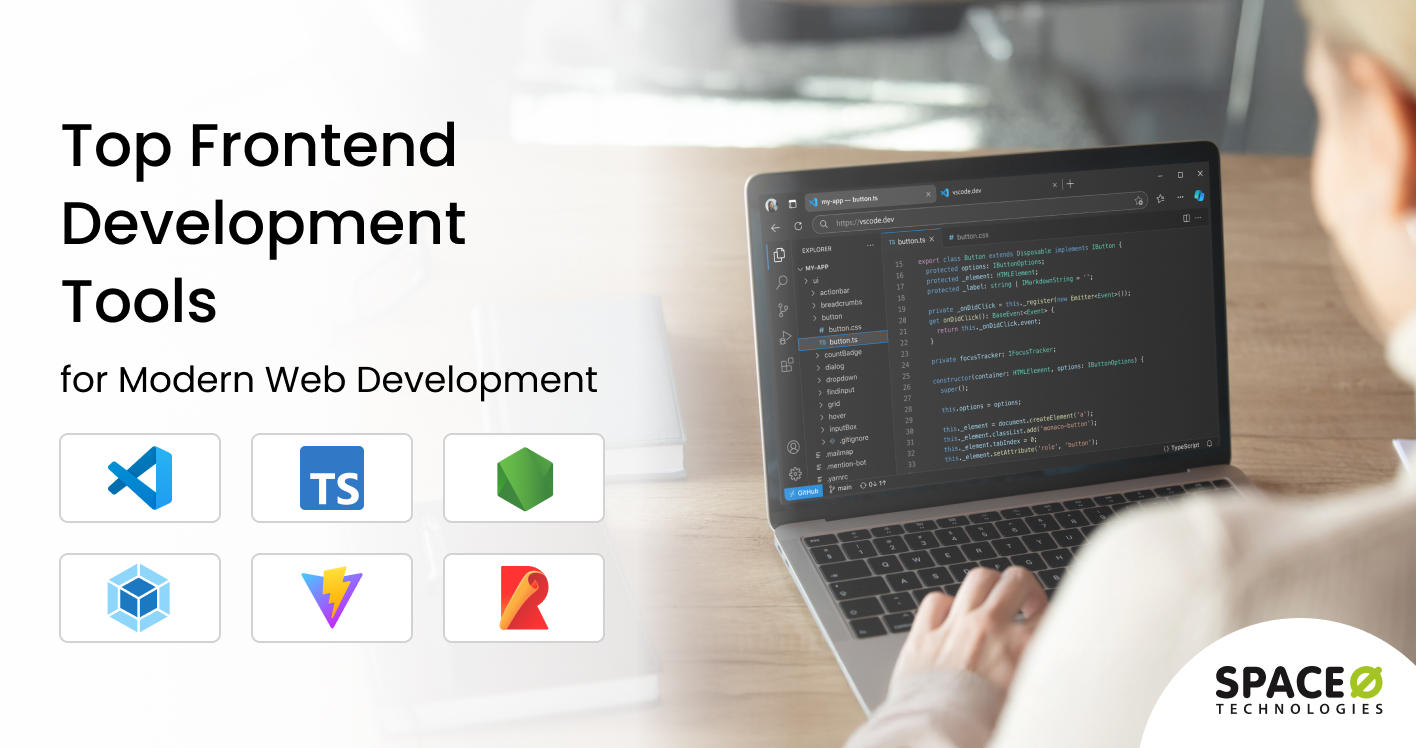
Modern frontend development extends far beyond basic frameworks. It’s about leveraging specialized tools that most businesses overlook.
While everyone discusses React and Angular, the real competitive advantage lies in performance optimization tools like Lighthouse, design collaboration with Figma, and next-generation build tools like Vite that deliver sub-second loading times.
Poor toolchain choices cost businesses dearly: 7% conversion loss per second of delay and 53% mobile abandonment after 3 seconds (Google).
At Space-O Technologies, our frontend developers focus on utilizing modern and innovative technologies tailored to the client’s frontend requirements.
With 15 years of experience, we’ve successfully completed over 350 projects across various industries, establishing us as experts in how frontend development tools can enhance your web application’s performance.
In this guide, we will explore 15 tools for frontend application development that advance workflow and provide web applications with highly responsive, scalable user interfaces.
Quick Glance: 15 Frontend Development Tools
Need a quick overview of all the tools? Here’s your complete reference table
| Tool | Category | Best For | Key Benefit |
|---|---|---|---|
| Visual Studio Code | Code Editor | All projects | Universal, extensible editor |
| WebStorm | IDE | Enterprise projects | Advanced debugging & features |
| TypeScript | Language | Type safety | Prevents runtime errors |
| Node.js | Runtime | Full-stack development | JavaScript everywhere |
| Webpack | Build Tool | Complex applications | Powerful bundling & optimization |
| Vite | Build Tool | Modern projects | Lightning-fast development |
| Rollup | Build Tool | Library development | Optimized package bundling |
| Sass/SCSS | CSS Preprocessor | Large-scale styling | Organized, maintainable CSS |
| Tailwind CSS | CSS Framework | Rapid development | Utility-first styling |
| PostCSS | CSS Processor | CSS optimization | Future CSS features today |
| Jest | Testing | Unit testing | Comprehensive test framework |
| Cypress | Testing | End-to-end testing | Real browser testing |
| ESLint | Code Quality | Code standards | Consistent code quality |
| Prettier | Formatting | Code formatting | Automatic style consistency |
| Lighthouse | Performance | Performance optimization | Web performance auditing |
Now, let’s get a detailed overview of the frontend developer technologies and tools in the next section. These tools are important when you are asking yourself how to create a web application.
List of 15 Frontend Development Technologies and Tools
Beyond choosing the right framework, successful frontend development depends on a carefully curated toolchain that addresses every aspect of the development lifecycle. These frontend technologies and tools have been proven in production environments and are actively used by our web developers at Space-O Technologies.
1. Visual Studio Code: The industry standard tool
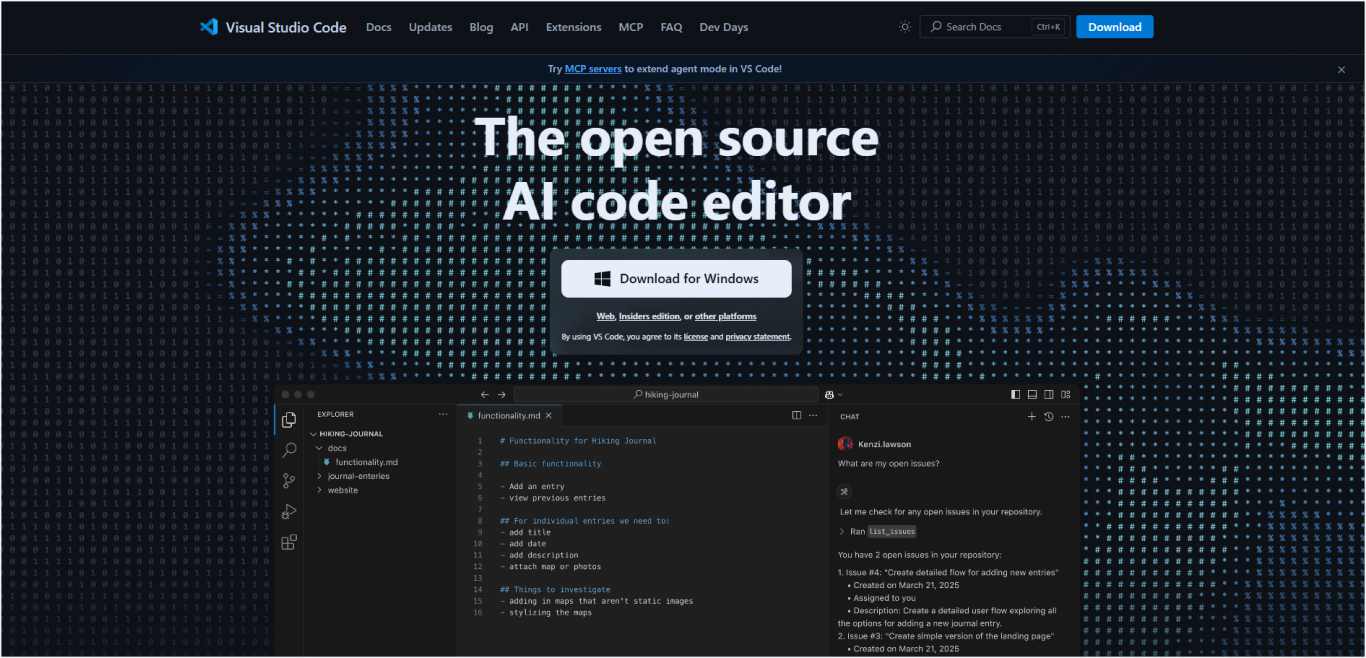
Visual Studio Code is a free, open-source code editor developed by Microsoft that has become the most popular choice among frontend developers worldwide. It combines the simplicity of a text editor with powerful IDE features, offering an extensible platform that adapts to any development workflow through its marketplace of extensions.
Key features and capabilities
- IntelliSense provides intelligent code completion based on variable types, function definitions, and imported modules.
- Integrated debugging supports breakpoints, call stacks, and an interactive console for JavaScript and TypeScript.
- Built-in Git integration enables version control operations directly within the editor.
- The extension marketplace offers 40,000+ extensions for languages, themes, and tools.
- Live Share enables real-time collaborative editing and debugging sessions.
- Integrated terminal provides command-line access without leaving the editor.
- Multi-cursor editing allows simultaneous editing at multiple locations.
- Code folding and minimap help navigate large files efficiently.
How frontend developers use Visual Studio Code
Frontend developers use VS Code’s extensions and workspace configurations to create optimized development environments for React, Angular, and Vue.js projects while maintaining consistency across team members.
Moving from your code editor to a more comprehensive development environment, professional teams often require advanced IDE capabilities for complex projects and enterprise-scale applications.
2. WebStorm: Professional IDE for JavaScript development
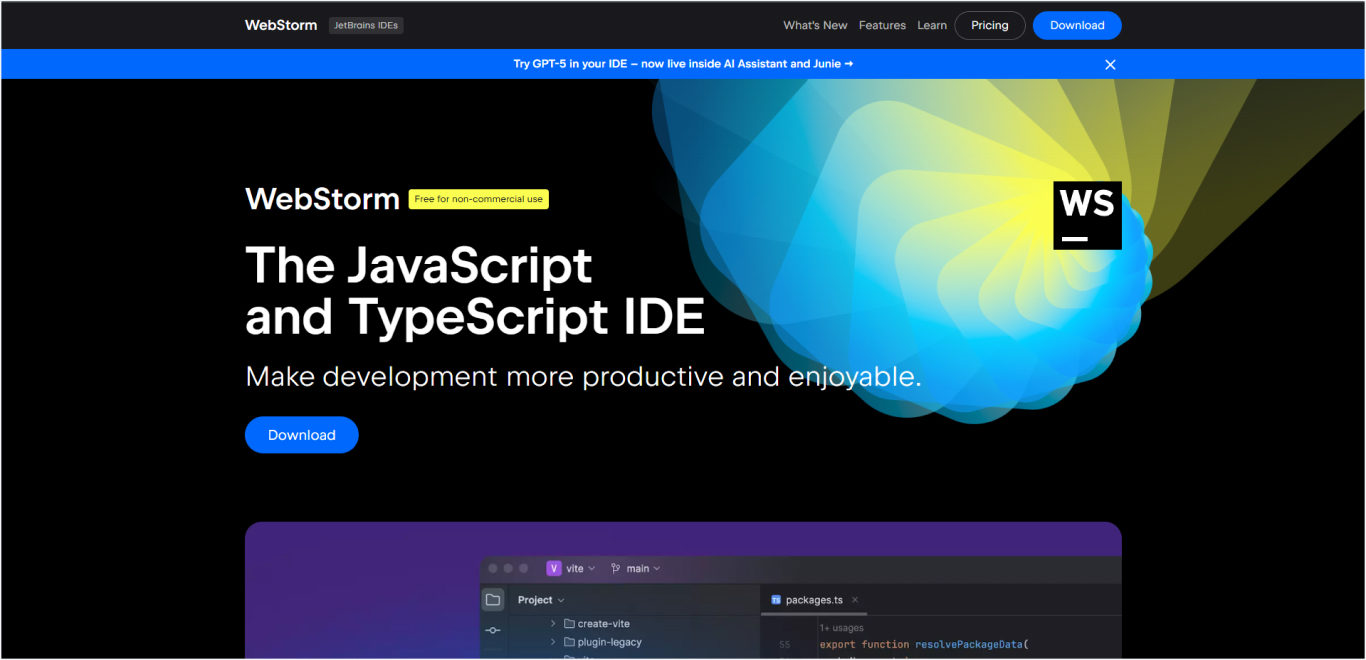
WebStorm is a commercial integrated development environment developed by JetBrains specifically for JavaScript and TypeScript development. It provides advanced code intelligence, powerful debugging tools, and built-in support for modern frameworks, making it ideal for professional development teams working on complex applications.
Key features and capabilities
- Advanced code completion with deep understanding of JavaScript frameworks and TypeScript frameworks
- Powerful debugging tools, including step-by-step debugging, breakpoints, and variable inspection
- Built-in testing framework support for Jest, Mocha, Karma, and other testing tools
- Intelligent code refactoring with safe rename, extract method, and move file operations
- Database integration for full-stack development with SQL support
- VCS integration supporting Git, SVN, Mercurial, and Perforce
- Code quality analysis with built-in inspection and quick-fix suggestions
- Framework-specific support for React, Angular, Vue.js, and Node.js
How frontend developers use WebStorm
The top frontend development company, like Space-O Technologies, and developers use WebStorm for complex enterprise applications requiring advanced debugging, refactoring capabilities, and integrated database tools for full-stack JavaScript development projects.
3. TypeScript: Static type checking for JavaScript
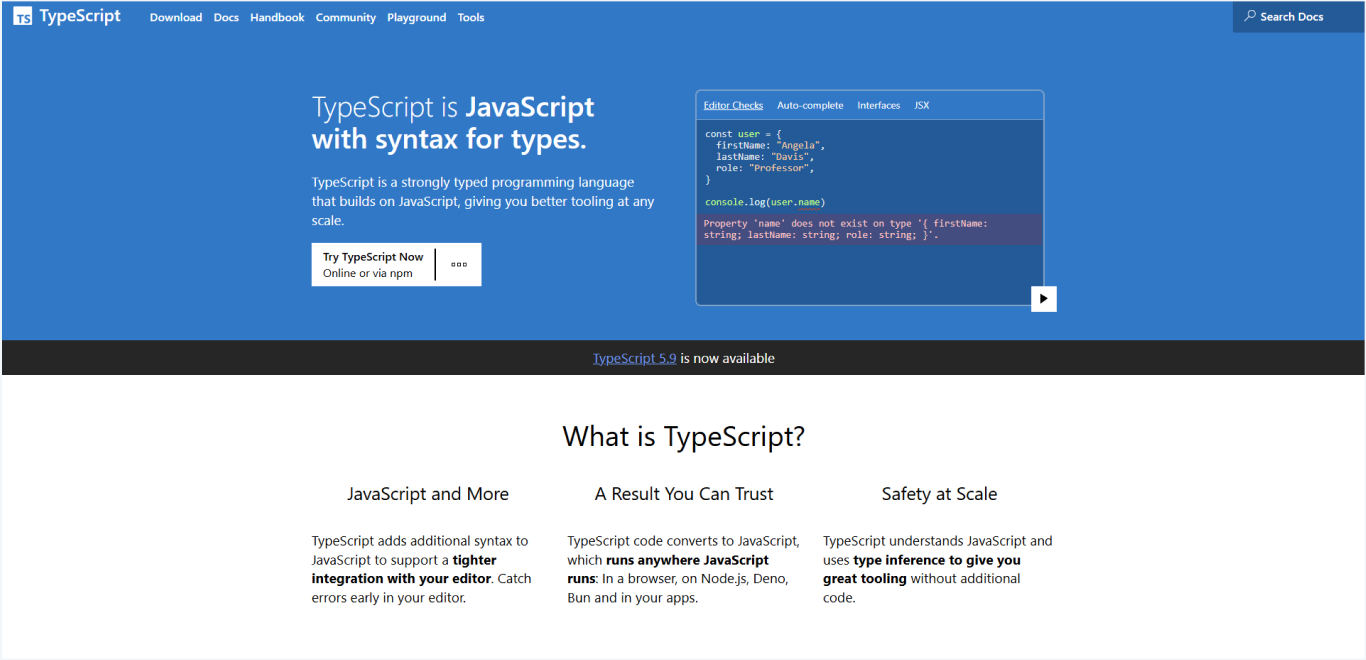
TypeScript is a programming language developed by Microsoft that builds on JavaScript by adding static type definitions. It compiles to plain JavaScript and runs anywhere JavaScript runs, providing developers with optional static typing, enhanced IDE support, and early error detection during development.
Key features and capabilities
- Static type checking catches errors at compile time rather than runtime
- Enhanced IDE support with better autocompletion, refactoring, and navigation
- Interface definitions provide clear contracts for object shapes and API responses
- Generics support enables reusable components with type safety
- Advanced TypeScript features, including mapped types, conditional types, and utility types
- Gradual adoption allows incremental migration from existing JavaScript codebases
- Framework integration with excellent support for React, Angular, and Vue.js
- Tooling ecosyste,m including TSLint/ESLint integration and build tool support
How frontend developers use TypeScript
Frontend web developers implement TypeScript in React and Angular applications to prevent runtime errors, improve code maintainability, and enhance team collaboration through type definitions.
4. Node.js: JavaScript runtime for backend and tooling
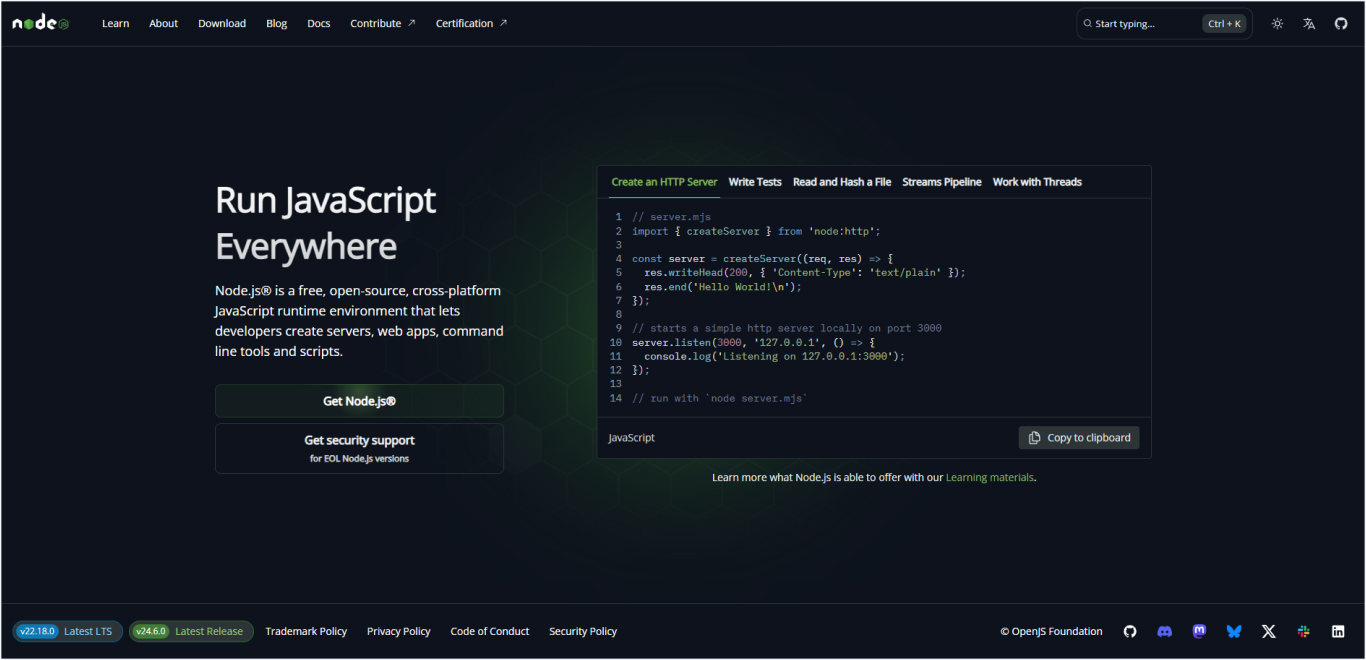
Node.js is a JavaScript runtime built on Chrome’s V8 JavaScript engine that allows developers to run JavaScript on the server side. It enables unified JavaScript development across the frontend while powering the entire ecosystem of the web development process.
Key features and capabilities
- Server-side JavaScript execution enables full-stack development with a single language.
- NPM package manager provides access to over 1 million open-source packages
- Event-driven architecture with non-blocking I/O for high-performance applications
- Cross-platform compatibility runs on Windows, macOS, and Linux systems
- Build tool foundation powers Webpack, Vite, and other essential development tools
- API development supports REST and GraphQL server development
- Microservices support enables scalable, distributed application architectures
- Development tooling includes testing frameworks, linters, and formatting tools
How frontend developers use Node.js
Frontend teams use Node.js to run build tools, package managers, and development servers while creating APIs that support their frontend applications.
Real-world example
Space-O Technologies delivered numerous web applications, including a web-based delivery management system that utilizes React.js for the frontend and Node.js for the backend. This system optimizes real-time delivery tracking, route optimization, and seamless notification workflows for stores, drivers, and customers through our expert Node js development services
5. Webpack: Module bundler for complex applications
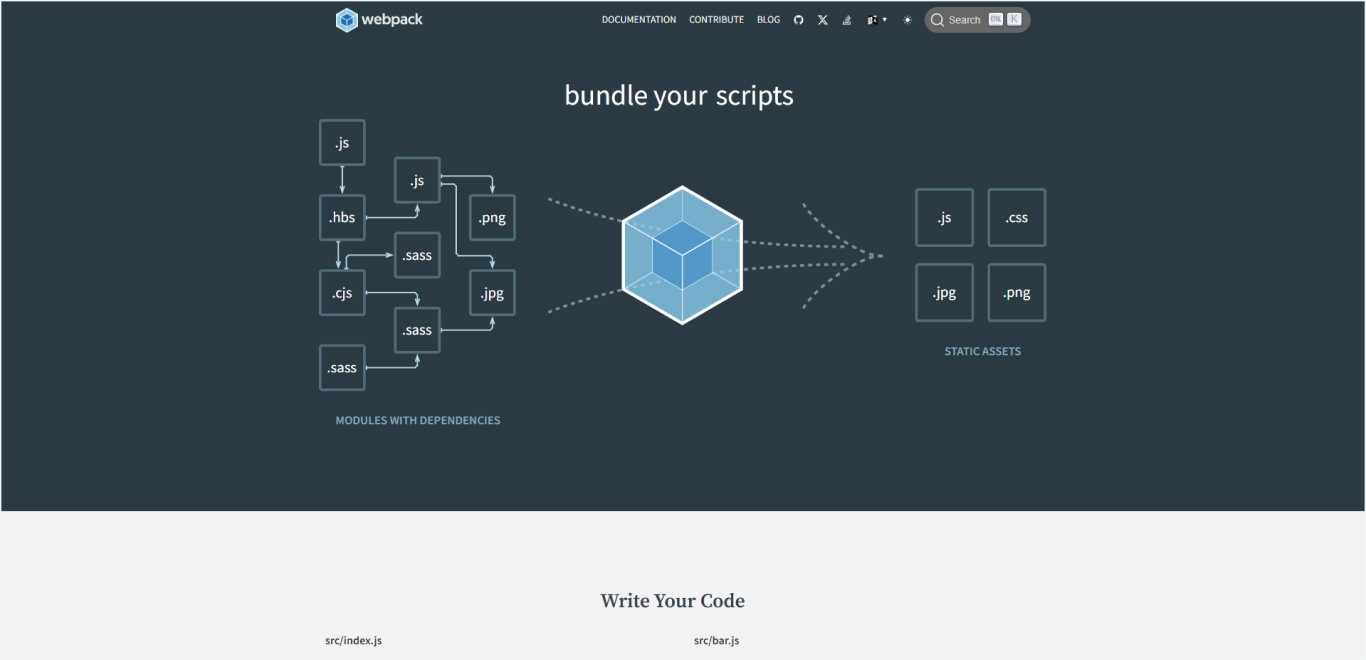
Webpack is a module bundler that takes modules with dependencies and generates static assets representing those modules. It processes JavaScript, CSS, images, and other assets through loaders and plugins, creating optimized bundles for production deployment while providing a powerful development server.
Key features and capabilities
- Module bundling combines multiple JavaScript files into optimized bundles
- Code splitting enables loading only the necessary code for better performance
- Tree shaking eliminates unused code from final bundles
- Asset processing handles images, fonts, CSS, and other static assets
- Hot Module Replacement updates modules during development without a full page refresh
- The plugin system extends functionality for specific requirements
- The development server provides live reloading and debugging capabilities
- Environment-specific builds optimize differently for development and production
How frontend developers use Webpack
Teams configure Webpack for React and Angular projects to bundle JavaScript modules, process CSS/Sass files, and optimize assets for production deployment.
At Space-O Technologies, our teams personalize the front-end build process for every client by expertly configuring Webpack in React and Angular projects. This enables seamless bundling of JavaScript modules, efficient processing of CSS, and delivers lightning-fast, streamlined web apps ready for production deployment.
While Webpack excels at complex configurations, newer build tools like Vite offer dramatically faster development experiences with modern approaches to bundling and serving code.
6. Vite: Next-generation frontend build tool
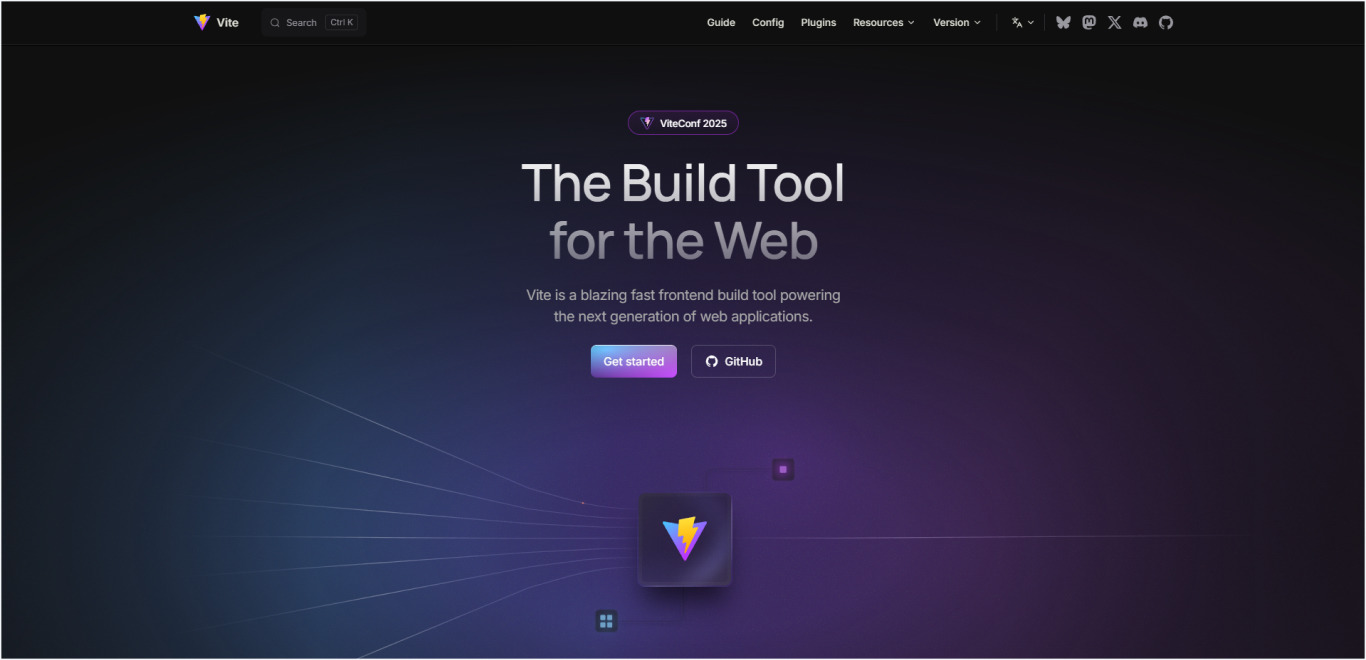
Vite is a build tool created by Evan You that provides a faster and leaner development experience for modern web projects. It leverages native ES modules and modern JavaScript features to deliver instant server start and lightning-fast hot module replacement during development.
Key features and capabilities
- Instant server start regardless of application size using native ES modules
- Lightning-fast HMR with updates typically under 100ms
- Optimized builds using Rollup for production with advanced optimizations
- Framework agnostic with official templates for React, Vue, Svelte, and vanilla JavaScript
- Plugin ecosystem supports TypeScript, JSX, and CSS preprocessors out of the box
- Dependency pre-bundling optimizes node_modules using esbuild
- Asset handling includes automatic optimization for images and other static assets
- CSS features support PostCSS, CSS modules, and preprocessors natively
How frontend developers use Vite
Modern development teams adopt Vite for React and Vue projects to achieve sub-second development server startup and instant hot module replacement.
Our frontend development agency uses Vite in our React and Vue projects to achieve lightning-fast server startups and instant hot module replacement, drastically reducing development time. This allows dedicated development teams to deliver features quickly, keep designers and developers in sync, and launch high-performance apps faster.
7. Rollup: Module bundler optimized for libraries
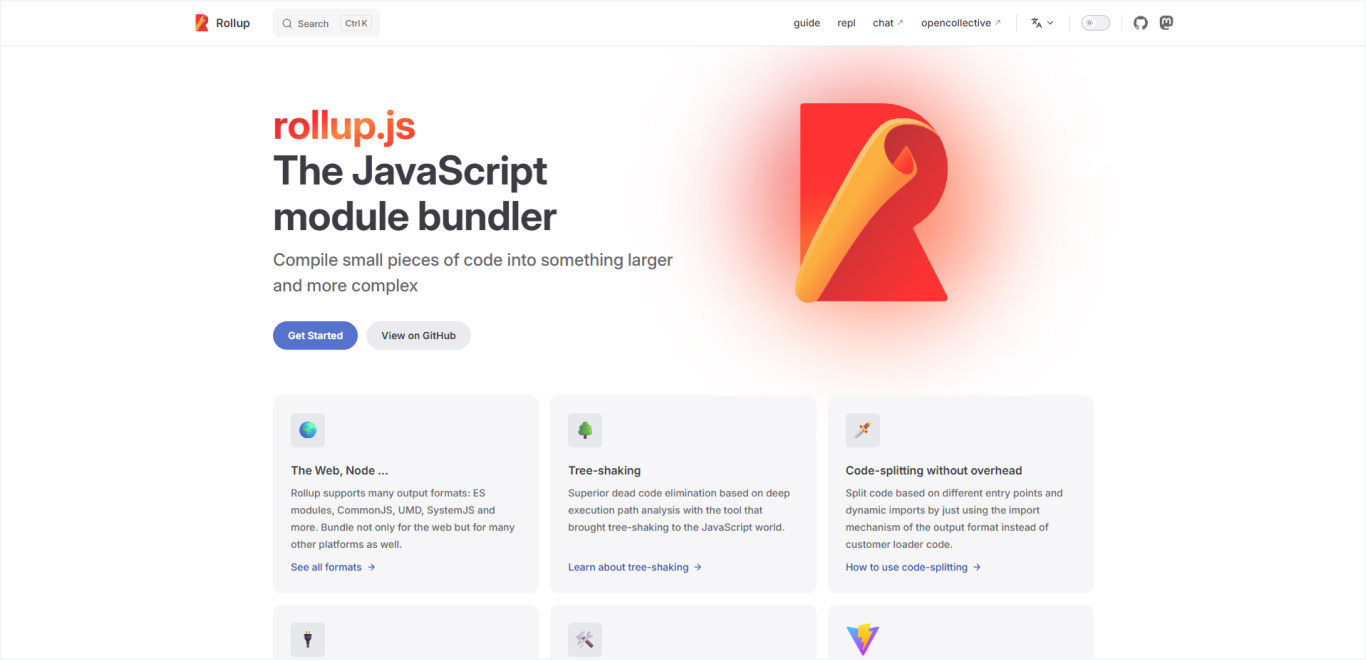
Rollup is a module bundler for JavaScript that compiles small pieces of code into larger, more complex applications or libraries. It’s particularly well-suited for creating libraries and packages that need to be consumed by other applications, focusing on ES module output and tree shaking.
Key features and capabilities
- ES module native output creates standards-compliant JavaScript modules
- Superior tree shaking eliminates unused code more effectively than other bundlers
- Multiple output formats support UMD, CommonJS, AMD, and ES module formats
- Efficient scope hoisting reduces bundle size and improves runtime performance
- Plugin architecture extends functionality through a rich ecosystem
- The development server provides live reloading for library development
- Source map generation enables debugging of bundled code
How frontend developers use Rollup
Library developers use Rollup to create highly optimized npm packages by leveraging its superior tree-shaking capabilities, which eliminate unused code to produce smaller, more efficient bundles.
8. Sass/SCSS: CSS preprocessor with variables and nesting
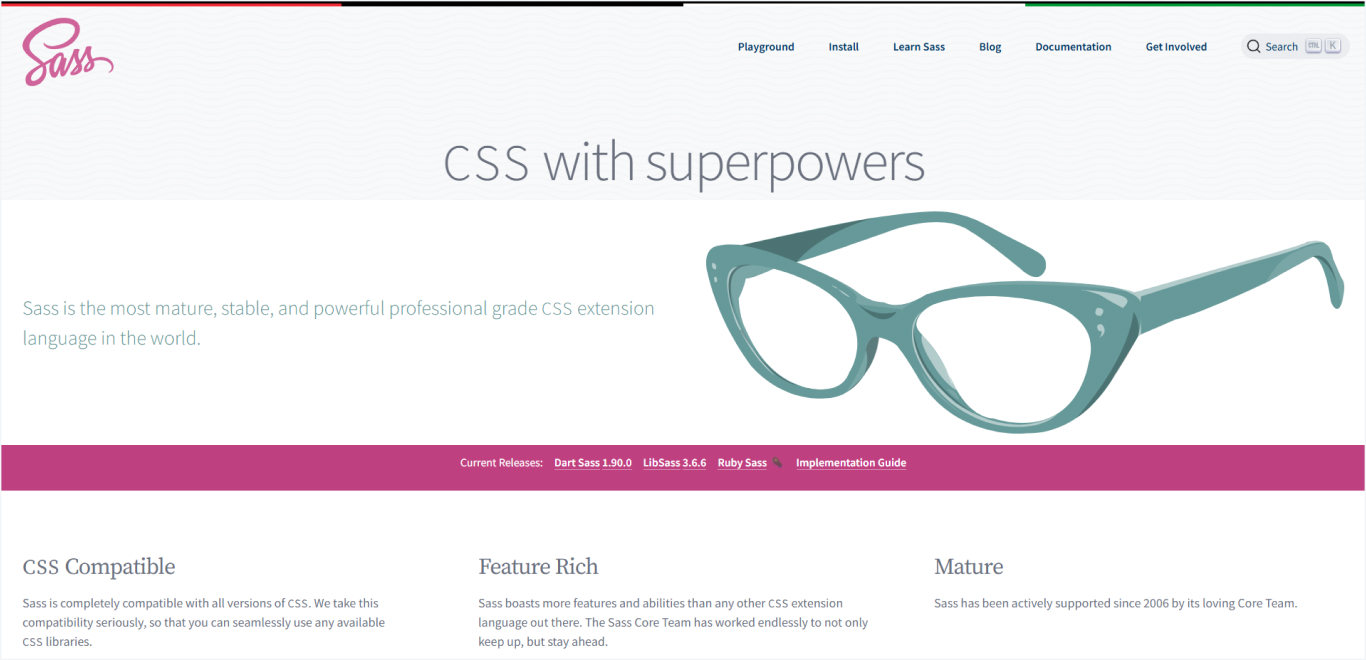
Sass (Syntactically Awesome Stylesheets) is a CSS preprocessor that adds programming features to CSS, including variables, nesting, mixins, and functions. SCSS syntax provides a CSS-compatible way to write Sass, making it easier to adopt in existing projects while maintaining familiar syntax.
Key features and capabilities
- Variables store reusable values for colors, fonts, and spacing throughout stylesheets.
- Nesting allows CSS selectors to be nested inside one another for better organization.
- Mixins create reusable groups of CSS declarations that can accept parameters
- Functions perform calculations and manipulate values dynamically
- Partials and imports enable modular stylesheet architecture
- Control directives include @if, @for, and @each for programmatic styling
- Built-in functions provide color manipulation, math operations, and string handling
- Source maps enable debugging of compiled CSS back to original Sass files
How frontend developers use Sass/SCSS
Experienced Web and mobile development teams from our frontend software development firm use Sass for large-scale applications to maintain consistent design systems, create reusable style components, and organize CSS architecture effectively.
9. Tailwind CSS: Utility-first CSS framework
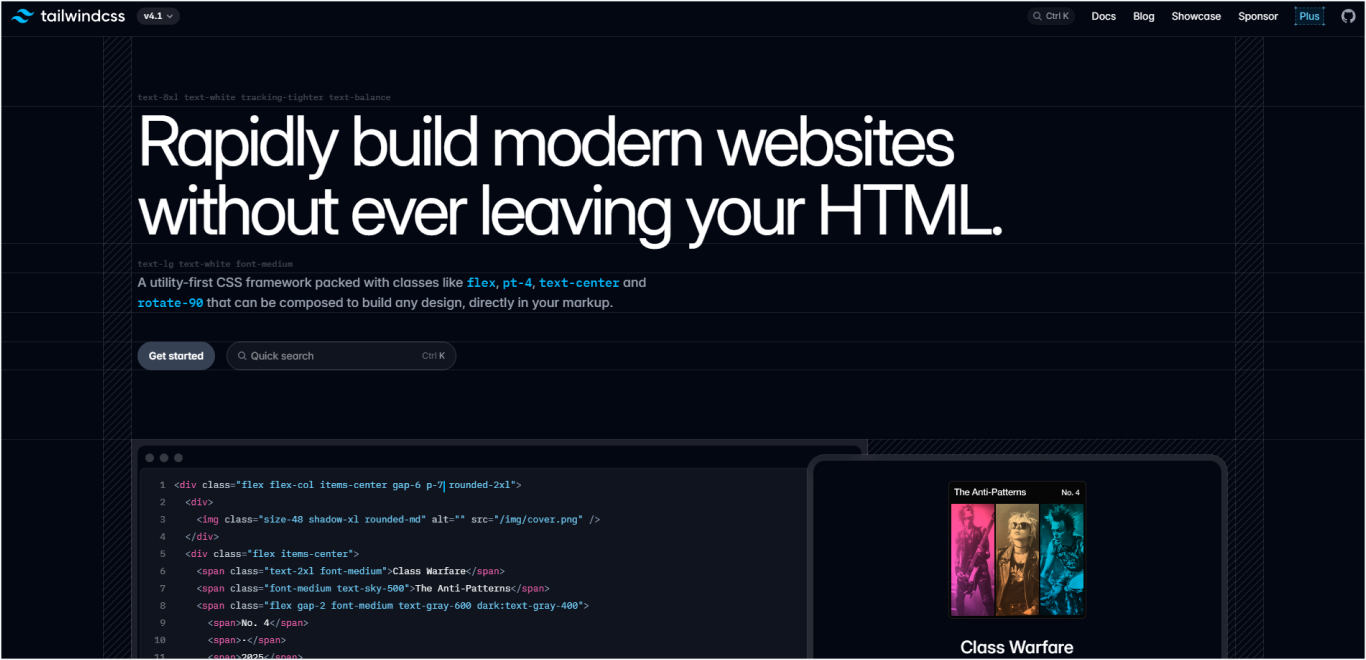
Tailwind CSS is a utility-first CSS framework that provides low-level utility classes to build custom designs directly in your markup. Unlike traditional CSS frameworks, Tailwind doesn’t include pre-designed components but instead offers building blocks to create unique designs efficiently.
Key features and capabilities
- Utility classes provide granular control over styling without writing custom CSS
- Responsive design built in with a mobile-first breakpoint system
- Customization through a comprehensive configuration file for colors, spacing, and typography
- PurgeCSS integration removes unused styles for optimal production bundle sizes
- Design tokens ensure consistent spacing, colors, and typography across projects
- Component extraction enables reusable patterns while maintaining a utility approach
- JIT compilation generates styles on demand for faster builds and smaller file sizes
- Plugin system extends functionality with official and community plugins
How frontend developers use Tailwind CSS
Expert frontend web development teams from our agency utilize Tailwind CSS to accelerate both rapid prototyping and production development, enabling consistent and visually cohesive designs without the need for extensive custom CSS.
This approach provides the flexibility to adapt and fine-tune designs easily, ensuring fast delivery and high-quality user interfaces tailored to each client’s unique brand and requirements.
10. PostCSS: CSS transformation tool
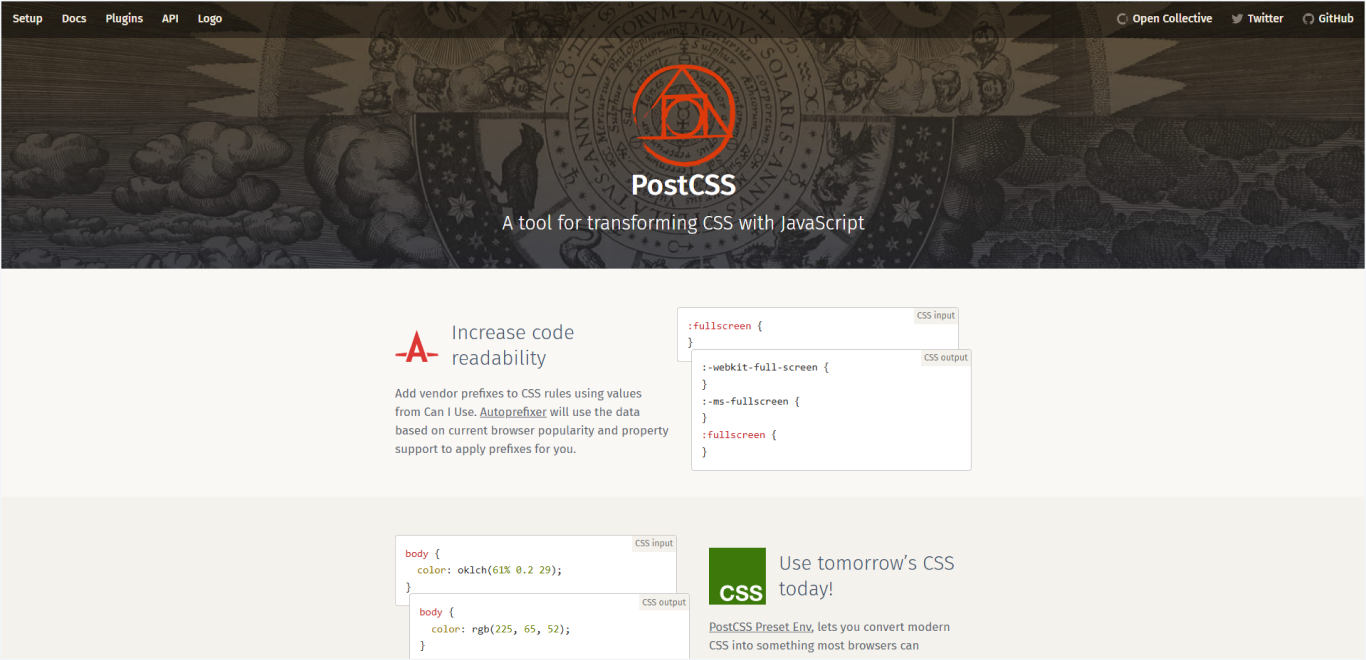
PostCSS is a tool for transforming CSS using JavaScript plugins. It analyzes CSS and transforms it through plugins that can add vendor prefixes, support future CSS features, optimize code, or perform custom transformations based on project requirements.
Key features and capabilities
- Plugin architecture enables modular CSS processing through configurable plugins.
- Autoprefixing automatically adds vendor prefixes for cross-browser compatibility.
- Future CSS features through plugins that polyfill upcoming CSS specifications.
- Optimization includes minification, dead code removal, and asset optimization.
- Custom transformations allow the creation of project-specific CSS processing.
- Build tool integration works with Webpack, Vite, Rollup, and other bundlers.
- Source maps preserve debugging information through the transformation pipeline.
- Performance optimization processes CSS faster than traditional preprocessors.
How frontend developers use PostCSS
Development teams integrate PostCSS into build pipelines to enable modern CSS features, ensure browser compatibility, and optimize stylesheets for production.
11. Jest: JavaScript testing framework
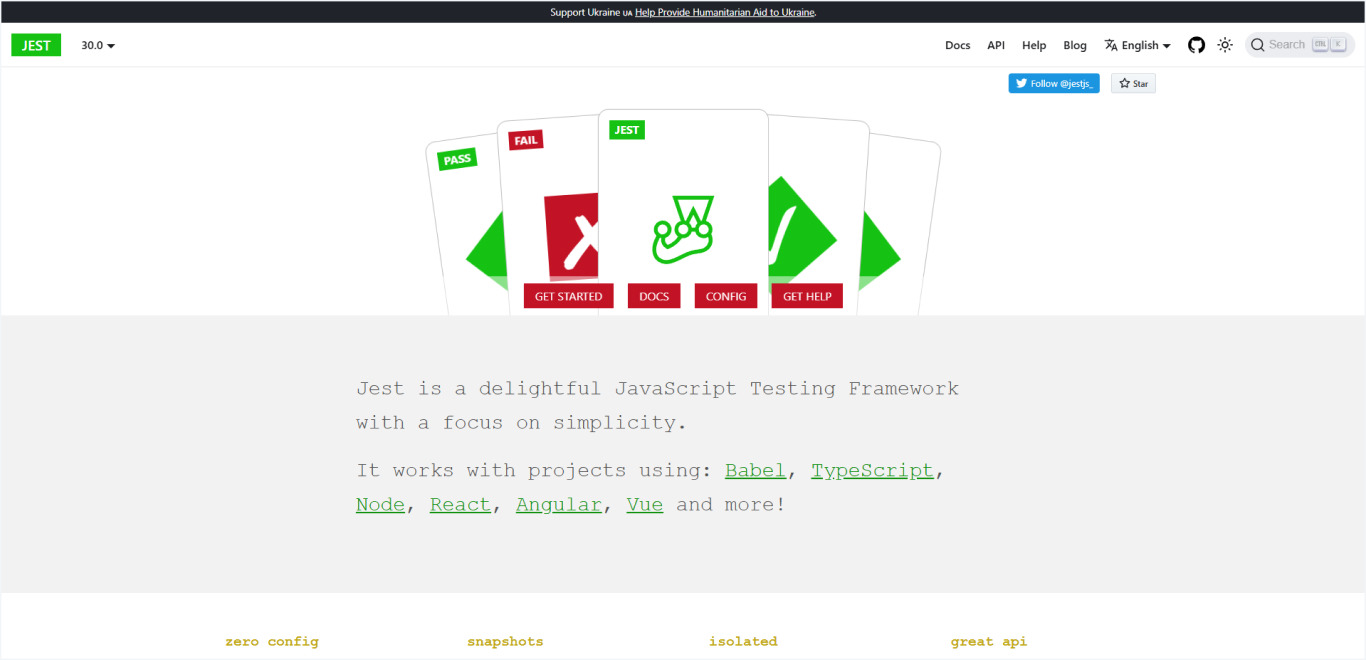
Jest is a comprehensive JavaScript testing framework developed by Facebook that provides everything needed to test JavaScript applications. It includes a test runner, an assertion library, mocking capabilities, and code coverage reporting in a single package with minimal configuration requirements.
Key features and capabilities
- Zero configuration works out of the box for most JavaScript projects
- Snapshot testing captures component output to detect unexpected changes
- Mocking system includes automatic mocks, manual mocks, and module mocking
- Code coverage provides detailed reports without additional setup
- Parallel testing runs tests concurrently for faster execution
- Watch mode automatically runs tests when files change during development
- The assertion library includes extensive matchers for different test scenarios
- async testing supports promises, async/await, and callback-based code
How frontend developers use Jest
Our web development teams use Jest to perform precise unit testing on React components and utility functions, ensuring every feature works exactly as intended. This rigorous testing approach helps us maintain high code quality, achieve comprehensive test coverage, and deliver reliable, bug-free applications to our clients.
12. Cypress: End-to-end testing framework
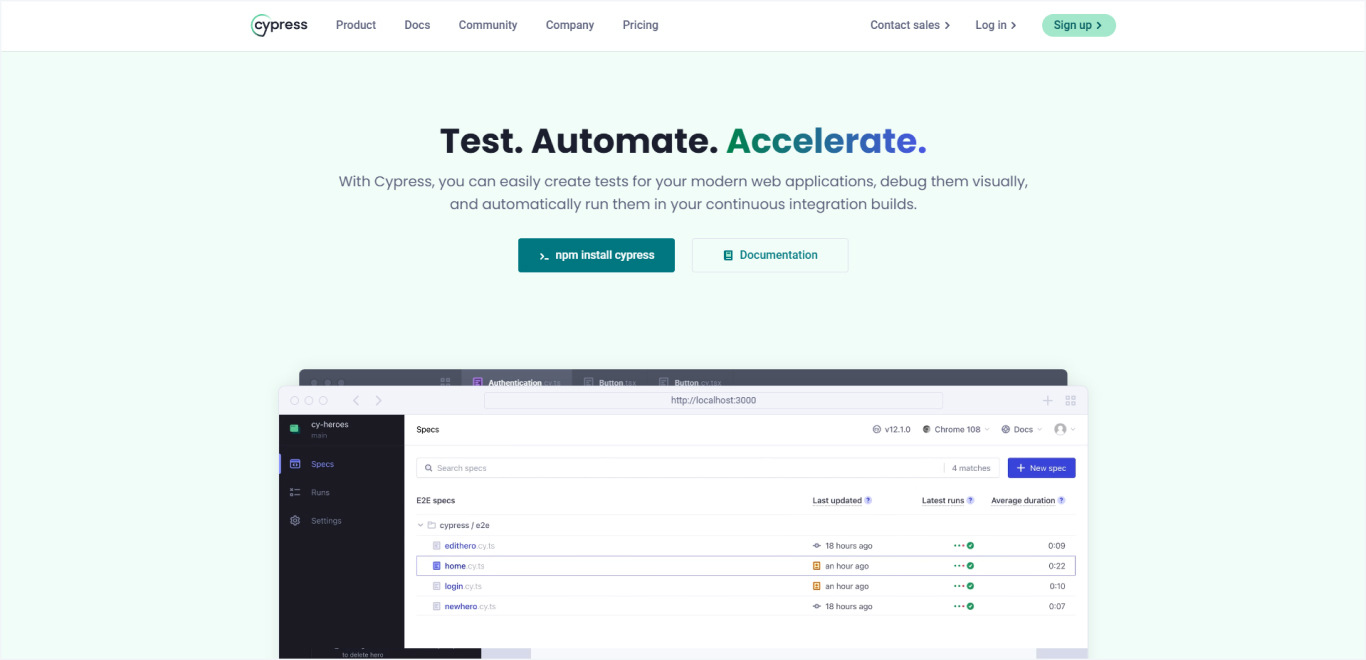
Cypress is a modern end-to-end testing framework that runs in the browser and provides a complete testing experience. It offers real-time browser testing, time-travel debugging, and automatic waiting, making it easier to write, debug, and maintain tests for web applications.
Key features and capabilities
- Real browser testing runs tests in actual browsers (Chrome, Firefox, Edge)
- Time-travel debugging allows inspection of the application state at any test step
- Automatic waiting eliminates the need for manual waits and reduces flaky tests
- Network stubbing enables testing different API scenarios and edge cases
- Visual testing includes screenshot comparison and visual regression detection
- Developer tools integrated browser DevTools for debugging during tests
- Test runner provides interactive test execution with detailed reporting
- CI/CD integration supports continuous integration and automated testing pipelines
How frontend developers use Cypress
QA teams and developers use Cypress to test critical user journeys, form submissions, and complex application workflows across different browsers. Beyond testing functionality, code quality tools ensure consistent coding standards and catch potential issues before they reach production environments.
If you are not sure which components to test, our web application testing checklist gives an overview.
13. ESLint: JavaScript linting and code quality
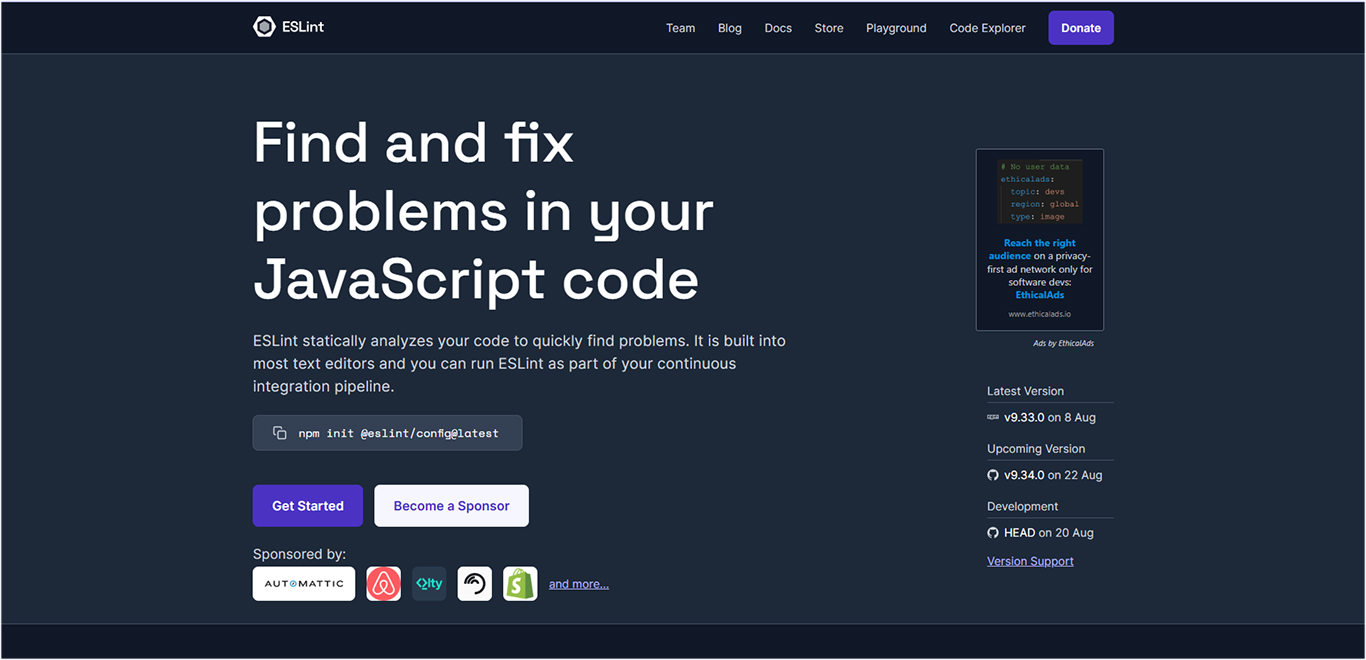
ESLint is a static code analysis tool for identifying problematic patterns in JavaScript code. It’s highly configurable and extensible, allowing teams to enforce coding standards, catch errors early, and maintain consistent code quality across projects and team members.
Key features and capabilities
- Configurable rules allow customization of coding standards and best practices.
- Error detection identifies syntax errors, potential bugs, and problematic patterns.
- Code style enforcement ensures consistent formatting and naming conventions
- Framework integration includes specific rules for React, Vue, Angular, and Node.js
- Plugin system extends functionality through community and custom plugins
- Automatic fixing corrects many rule violations automatically
- IDE integration provides real-time feedback during development
- Team collaboration enables shared configurations across development teams
How frontend developers use ESLint
Frontend websites are developed by our team, who perform code-quality testing. Using ESLint, each project’s unique codebase allows for early error detection and enforcement of best practices. This customized setup promotes cleaner code and smoother collaboration by aligning coding standards with the specific needs of every development team.
14. Prettier: Code formatting Tool
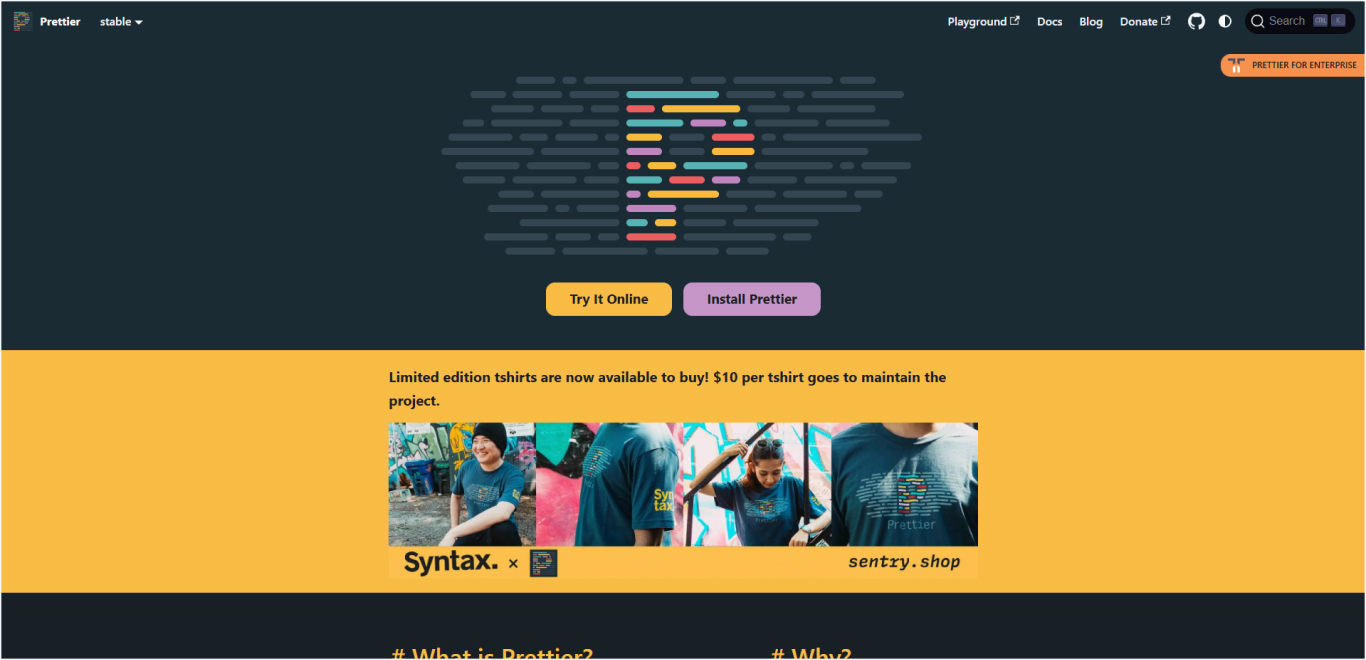
Prettier is an opinionated code formatter that enforces a consistent code style by parsing code and reformatting it according to its own rules. It supports multiple languages and integrates with editors and build processes to ensure consistent formatting across entire development teams.
Key features and capabilities
- Automatic formatting enforces consistent style without manual intervention
- Multi-language support handles JavaScript, TypeScript, CSS, HTML, JSON, and more
- Editor integration provides format-on-save functionality in popular editors
- Configurable options allow customization of key formatting preferences
- Team consistency eliminates formatting discussions and style debates
- Git integration can format code automatically through pre-commit hooks
- Build process integration ensures formatted code in production deployments
- Conflict resolution works alongside ESLint through shared configurations
How frontend developers use Prettier
Frontend experts use Prettier with pre-commit hooks and editor tools to automate code formatting, eliminating style conflicts and ensuring a consistent and clean codebase across all projects. This practice streamlines collaboration by allowing developers to focus on functionality while maintaining high-quality, readable code.
15. Lighthouse: Web performance auditing tool
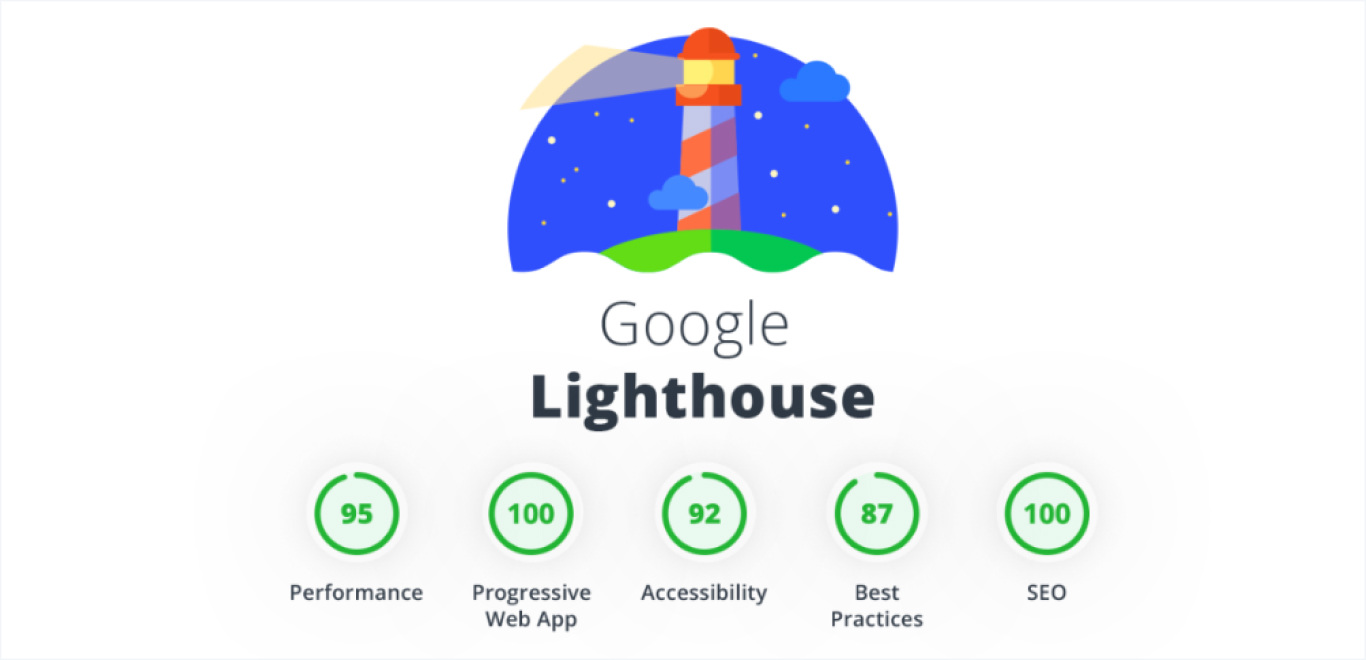
Lighthouse is an open-source tool developed by Google for auditing web page quality. It runs automated audits for performance, accessibility, SEO, and Progressive Web Apps (PWAs), providing detailed reports with specific recommendations for improvement.
Key features and capabilities
- Performance auditing measures Core Web Vitals and loading performance metrics.
- Accessibility testing identifies barriers for users with disabilities.
- SEO analysis evaluates search engine optimization factors.
- Progressive Web App assessment checks PWA compliance and features.
- Best practices evaluation covers security, performance, and modern web standards.
- Actionable recommendations provide specific steps for improvement with impact estimates.
- CI/CD integration enables automated performance monitoring in deployment pipelines.
- Multiple interfaces available through DevTools, CLI, and web interface.
How frontend developers use Lighthouse
Development teams integrate Lighthouse into workflows to monitor core web vitals, identify performance bottlenecks, and ensure optimal user experience across all applications.
Getting a clear, detailed overview of each tool helps you learned about their features and how developers use them for the frontend development process. In the next section, we will choose the tool based on your requirements.
Which Tools Should You Choose for Your Project?
Here’s a practical guide to help you choose the right combination of tools
For startup MVPs and rapid prototyping
| Tool Category | Recommended Tool | Why This Choice? |
|---|---|---|
| Code Editor | Visual Studio Code | Free, fast setup, extensive extensions |
| Build Tool | Vite | Instant server start, minimal configuration |
| Language | TypeScript | Catches errors early, better IDE support |
| CSS Framework | TailwindCSS | Rapid UI development, consistent design |
| Testing | Jest | Simple setup, comprehensive testing |
| Total Setup Time | 1-2 days | Perfect for speed and simplicity |
For enterprise applications
| Tool Category | Recommended Tool | Why This Choice? |
|---|---|---|
| IDE | WebStorm | Advanced debugging, enterprise features |
| Language | TypeScript | Type safety at scale, team collaboration |
| Build Tool | Webpack | Complex configurations, mature ecosystem |
| CSS Tool | Sass | Scalable architecture, design systems |
| Testing | Jest + Cypress | Comprehensive testing strategy |
| Quality | ESLint + Prettier | Code standards, team consistency |
| Total Setup Time | 1-2 weeks | Built for scale and reliability |
For component libraries and packages
| Tool Category | Recommended Tool | Why This Choice? |
|---|---|---|
| Code Editor | Visual Studio Code | Library-specific extensions available |
| Language | TypeScript | API documentation, type safety |
| Build Tool | Rollup | Optimized bundling, multiple formats |
| CSS Tool | PostCSS | Processing flexibility, optimization |
| Testing | Jest | Unit testing, coverage reporting |
| Performance | Lighthouse | Validation, performance benchmarks |
| Total Setup Time | 3-5 days | Optimized for distribution |
Using these tables, you can choose the right tech stack for frontend development projects and launch user-focused frontend designs for your web and mobile applications.
Here we’ve mentioned the tools that you can use for frontend development. But if you want to get a clear view of frontend frameworks and compare them, you may find this blog helpful.
Not Sure Which Tools Fit Your Project?
Our frontend specialists will review your project needs and recommend the exact tool stack – no guesswork, no bloated dependencies.

Ready to Implement These Tools Successfully?
That’s where professional implementation makes the difference.
Here’s the reality: knowing about these tools is one thing and implementing them correctly is another. Many businesses try to set up these tools themselves, only to face:
- Configuration nightmares that waste weeks
- Team resistance due to poor training
- Performance issues from incorrect setup
- Integration problems that break workflows
What makes Space-O’s approach to frontend development different
After deploying on hundreds of successful projects, follow a frontend development process that eliminates guesswork and ensures smooth adoption:
Phase 1: Foundation setup (Week 1-2)
- Development environment standardization across your entire team
- Code quality tool configuration with your specific requirements
- Version control workflow establishment for seamless collaboration
- Team onboarding with hands-on training sessions
Phase 2: Build process optimization (Week 2-3)
- Build tool selection and configuration based on your project needs
- CSS processing pipeline setup for maintainable, scalable styles
- Asset optimization implementation for maximum performance
- Development workflow integration that fits your team’s habits
Phase 3: Quality assurance integration (Week 3-4)
- Testing framework implementation with comprehensive coverage
- Performance monitoring setup with baseline establishment
- Continuous integration configuration for automated quality checks
- Documentation and best practices for long-term success
Why choose professional frontend development help from our company?
- Time savings: What takes most teams 2-3 months, we complete in 3-4 weeks.
- Reduced risk: Our proven process eliminates common pitfalls and configuration errors.
- Team adoption: Proper training ensures your team uses the tools effectively.
- Ongoing support: We provide continued guidance as your project evolves.
Take Your Next Steps: Build a Web Application With a Scalable Frontend Based on Your Needs
Don’t struggle with tool implementation on your own. Let our experts set up the perfect development environment tailored to your specific needs.
What you get
✅ Complete tool stack setup and configuration
✅ Team training and best practices documentation
✅ Performance optimization and monitoring
✅ Ongoing support and consultation
✅ 97% client satisfaction guarantee
Get started today with our comprehensive Frontend Development Services and discover why businesses trust us with their web development needs.
Build Your Frontend Application With Pre-Vetted Team
Ready to build a complete web application? Our frontend experts use these exact tools to deliver high-performance solutions.
FAQ About Front-End Development Tools
Do I need all these tools for every project?
No, tool selection should match project requirements and team capacity. Begin with core tools such as VS Code, TypeScript, and essential build tools, and then add others as needed based on project complexity and team requirements.
How do these tools integrate with existing frameworks?
These tools complement frontend frameworks rather than replace them. Most tools integrate seamlessly with React, Angular, Vue.js, and other frameworks through plugins and configuration options.
What’s the learning curve for implementing these tools?
A basic implementation can be set up rapidly using default settings. For advanced optimization, a more in-depth understanding is necessary, but it offers notable advantages. We suggest a gradual approach, beginning with the essential tools.
How do I convince my team to adopt new tools?
Start with pilot projects to demonstrate benefits and then measure improvements in development speed, code quality, and bug reduction. Our Space-O team can provide training and support during transition periods.
Are these tools suitable for large enterprise projects?
Yes, all these tools are production-ready and enterprise-tested. Many are specifically designed for large-scale applications and are used by major technology companies worldwide. Space-O has launched several large projects for global enterprises, which contribute to their long-term success.


